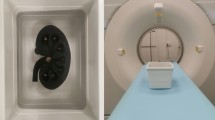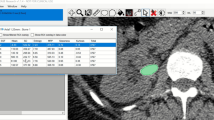Abstract
Purpose
Posterior acoustic shadow width has been proposed as a more accurate measure of kidney stone size compared to direct measurement of stone width on ultrasound (US). Published data in humans to date have been based on a research using US system. Herein, we compared these two measurements in clinical US images.
Methods
Thirty patient image sets where computed tomography (CT) and US images were captured less than 1 day apart were retrospectively reviewed. Five blinded reviewers independently assessed the largest stone in each image set for shadow presence and size. Shadow size was compared to US and CT stone sizes.
Results
Eighty percent of included stones demonstrated an acoustic shadow; 83% of stones without a shadow were ≤ 5 mm on CT. Average stone size was 6.5 ± 4.0 mm on CT, 10.3 ± 4.1 mm on US, and 7.5 ± 4.2 mm by shadow width. On average, US overestimated stone size by 3.8 ± 2.4 mm based on stone width (p < 0.001) and 1.0 ± 1.4 mm based on shadow width (p < 0.0098). Shadow measurements decreased misclassification of stones by 25% among three clinically relevant size categories (≤ 5, 5.1–10, > 10 mm), and by 50% for stones ≤ 5 mm.
Conclusions
US overestimates stone size compared to CT. Retrospective measurement of the acoustic shadow from the same clinical US images is a more accurate reflection of true stone size than direct stone measurement. Most stones without a posterior shadow are ≤ 5 mm.


Similar content being viewed by others
Abbreviations
- CT:
-
Computed tomography
- US:
-
Ultrasound
- BMI:
-
Body mass index
- ICC:
-
Intra-class correlation
References
Hubner WA, Irby P, Stoller ML (1993) Natural history and current concepts for the treatment of small ureteral calculi. Eur Urol 24:172–176
Assimos D et al (2016) Surgical management of stones: American Urological Association/Endourological Society Guideline. PART II. J Urol 196:1161–1169
Fowler KAB, Locken JA, Duchesne JH, Williamson MR (2002) US for detecting renal calculi with nonenhanced CT as a reference standard. Radiology 222:109–113
Ray AA, Ghiculete D, Pace KT, Honey RJD (2010) Limitations to ultrasound in the detection and measurement of urinary tract calculi. Urology 76:295–300
Sternberg KM et al (2016) Ultrasonography significantly overestimates stone size when compared to low-dose. Noncontrast computed tomography. Urology 95:67–71
Smith-Bindman R et al (2014) Ultrasonography vs computed tomography for suspected nephrolithiasis. N Engl J Med 371:1100–1110
Ferrandino MN et al (2009) Radiation exposure in the acute and short-term management of urolithiasis at 2 academic centers. J Urol 181:668–673
Coursey CA et al (2012) ACR Appropriateness Criteria® acute onset flank pain-suspicion of stone disease. Ultrasound Q 28:227–233
Dunmire B et al (2016) Use of the acoustic shadow width to determine kidney stone size with ultrasound. J Urol 195:171–176
May PC, Haider Y, Dunmire B, Cunitz BW, Thiel J, Liu Z, Bruce M, Bailey MR, Sorensen MD, Harper JD (2016) Stone-mode ultrasound for determining renal stone size. J Endourol 30(9):958–962
Dunmire B et al (2015) Tools to improve the accuracy of kidney stone sizing with ultrasound. J Endourol 29:147–152
Kanno T et al (2014) The efficacy of ultrasonography for the detection of renal stone. Urology 84:285–288
Kishore TAA, Pedro RN, Hinck B, Monga M (2008) Estimation of size of distal ureteral stones: noncontrast CT scan versus actual size. Urology 72:761–764
Ganesan V, De S, Greene D, Torricelli FCM, Monga M (2017) Accuracy of ultrasonography for renal stone detection and size determination: is it good enough for management decisions? BJU Int 119:464–469
Sternberg KM, Littenberg B (2017) Trends in imaging use for the evaluation and follow-up of kidney stone disease: a single center experience. J Urol 198:383–388
Patel SR et al (2011) Automated renal stone volume measurement by noncontrast computerized tomography is more reproducible than manual linear size measurement. J Urol 186:2275–2279
Lidén M, Andersson T, Geijer H (2011) Making renal stones change size-impact of CT image post processing and reader variability. Eur Radiol 21:2218–2225
Acknowledgements
This work is part of a large collaborative effort, and we appreciate the help of our many collaborators at the University of Vermont, University of Washington (UW) Center for Industrial and Medical Ultrasound, the UW Department of Urology, and within National Institute of Diabetes and Digestive Kidney Diseases (NIDDK) Program Project DK043881.
Funding
Funding was provided by the National Space Biomedical Research Institute through National Aeronautics and Space Association (NASA) Grant NCC 9-58 and National Institute of Diabetes and Digestive and Kidney Diseases (NIDDK) Grant DK043881.
Author information
Authors and Affiliations
Contributions
JCD: Project development, data collection and management, data analysis, manuscript writing/editing. BD: Project development, data collection and management, data analysis, manuscript writing/editing. KMS: Project development, data collection, manuscript editing. ZL: Data analysis, manuscript editing. TL: Data collection and management, manuscript editing. JT: Data collection, manuscript editing. HCC: Data collection, manuscript editing. JDH: Project development, manuscript editing. MRB: Project development, manuscript writing/editing. MDS: Project development, data collection, manuscript editing.
Corresponding author
Ethics declarations
Conflict of interest
Michael R. Bailey, Barbrina Dunmire, and Mathew D. Sorensen have equity in and consulting agreements with SonoMotion Inc. which has licensed intellectual property from the University of Washington related to this technology. For the remaining authors, no competing conflicts of interest exist.
Ethical approval
All procedures performed in studies involving human participants were in accordance with the ethical standards of the institutional and/or national research committee and with the 1964 Helsinki declaration and its later amendments or comparable ethical standards. For this type of study formal consent is not required.
Rights and permissions
About this article
Cite this article
Dai, J.C., Dunmire, B., Sternberg, K.M. et al. Retrospective comparison of measured stone size and posterior acoustic shadow width in clinical ultrasound images. World J Urol 36, 727–732 (2018). https://doi.org/10.1007/s00345-017-2156-8
Received:
Accepted:
Published:
Issue Date:
DOI: https://doi.org/10.1007/s00345-017-2156-8




